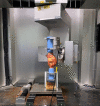The Role of the Medial Meniscus in Anterior Knee Stability
- PMID: 36389621
- PMCID: PMC9663633
- DOI: 10.1177/23259671221132845
The Role of the Medial Meniscus in Anterior Knee Stability
Abstract
Background: Few studies have compared the force distribution between the anterolateral, posterolateral, and medial structures of the knee.
Purpose: To investigate the important structures in an intact knee contributing to force distribution in response to anterior tibial load.
Study design: Controlled laboratory study.
Methods: Nine fresh-frozen cadaveric knee specimens underwent robotic testing. First, 100 N of anterior tibial load was applied to the intact knee at 0°, 15°, 30°, 60°, and 90° of knee flexion. The anterior cruciate ligament (ACL), anterolateral capsule, lateral collateral ligament, popliteal tendon, posterior root of the lateral meniscus, superficial medial collateral ligament, posterior root of the medial meniscus (MM), and posterior cruciate ligament were then completely transected in sequential order. After each transection, the authors reproduced the intact knee motion when a 100-N anterior tibial load was applied. By applying the principle of superposition, the resultant force of each structure was determined based on the 6 degrees of freedom force/torque data of each state.
Results: At every measured knee flexion angle, the resultant force of the ACL was the largest of the tested structures. At knee flexion angles of 60° and 90°, the resultant force of the MM was larger than that of all other structures with the exception of the ACL.
Conclusion: The MM was identified as playing an important role in response to anterior tibial load at 60° and 90° of flexion.
Clinical relevance: In clinical settings, the ACL of patients with a poorly functioning MM, such as tear of the MM posterior root, should be monitored considering the large resultant force in response to an anterior tibial load.
Keywords: anterior cruciate ligament; anterior tibial load; biomechanics; fresh-frozen cadaver; lateral meniscus; medial collateral ligament; medial meniscus; robotic system.
© The Author(s) 2022.
Conflict of interest statement
One or more of the authors has declared the following potential conflict of interest or source of funding: This work was partially funded by a MEXT/JSPS KAKENHI grant (JP 20K18035). AOSSM checks author disclosures against the Open Payments Database (OPD). AOSSM has not conducted an independent investigation on the OPD and disclaims any liability or responsibility relating thereto.
Figures


Similar articles
-
Unhappy triad of the knee: What are the current concepts and opinions?World J Orthop. 2023 May 18;14(5):268-274. doi: 10.5312/wjo.v14.i5.268. eCollection 2023 May 18. World J Orthop. 2023. PMID: 37304199 Free PMC article. Review.
-
The Anterolateral Capsule of the Knee Behaves Like a Sheet of Fibrous Tissue.Am J Sports Med. 2017 Mar;45(4):849-855. doi: 10.1177/0363546516674477. Epub 2016 Dec 8. Am J Sports Med. 2017. PMID: 27932332
-
Longitudinal tear of the medial meniscus posterior horn in the anterior cruciate ligament-deficient knee significantly influences anterior stability.Am J Sports Med. 2011 Oct;39(10):2187-93. doi: 10.1177/0363546511416597. Epub 2011 Aug 9. Am J Sports Med. 2011. PMID: 21828365
-
Posterior Medial Meniscus Root Tears Potentiate the Effect of Increased Tibial Slope on Anterior Cruciate Ligament Graft Forces.Am J Sports Med. 2020 Feb;48(2):334-340. doi: 10.1177/0363546519889628. Epub 2019 Dec 10. Am J Sports Med. 2020. PMID: 31821011
-
Partial meniscectomy does not affect the biomechanics of anterior cruciate ligament reconstructed knee with a lateral posterior meniscal root tear.Knee Surg Sports Traumatol Arthrosc. 2020 Nov;28(11):3481-3487. doi: 10.1007/s00167-020-06209-9. Epub 2020 Sep 5. Knee Surg Sports Traumatol Arthrosc. 2020. PMID: 32889558
Cited by
-
Changes in the Elongation Pattern of the Medial Collateral Ligament During a Single-Leg Squat After Anterior Cruciate Ligament Reconstruction.Orthop J Sports Med. 2024 Nov 5;12(11):23259671241283795. doi: 10.1177/23259671241283795. eCollection 2024 Nov. Orthop J Sports Med. 2024. PMID: 39507327 Free PMC article.
-
Surgeon anterior cruciate ligament reconstruction volume and rates of concomitant meniscus repair.J Exp Orthop. 2023 Jun 8;10(1):61. doi: 10.1186/s40634-023-00626-8. J Exp Orthop. 2023. PMID: 37289299 Free PMC article.
-
A Reverse Suture Anchor Technique for Arthroscopic Medial Meniscus Root Repair.Arthrosc Tech. 2024 Apr 6;13(6):102970. doi: 10.1016/j.eats.2024.102970. eCollection 2024 Jun. Arthrosc Tech. 2024. PMID: 39036396 Free PMC article.
-
Unhappy triad of the knee: What are the current concepts and opinions?World J Orthop. 2023 May 18;14(5):268-274. doi: 10.5312/wjo.v14.i5.268. eCollection 2023 May 18. World J Orthop. 2023. PMID: 37304199 Free PMC article. Review.
-
Histomorphometric analysis of anterior cruciate ligament bundles and anatomical insights into injury mechanisms.Sci Rep. 2025 Feb 25;15(1):6762. doi: 10.1038/s41598-025-88037-w. Sci Rep. 2025. PMID: 40000733 Free PMC article.
References
-
- Ahn JH, Bae TS, Kang KS, Kang SY, Lee SH. Longitudinal tear of the medial meniscus posterior horn in the anterior cruciate ligament-deficient knee significantly influences anterior stability. Am J Sports Med. 2011;39(10):2187–2193. - PubMed
-
- Allaire R, Muriuki M, Gilbertson L, Harner CD. Biomechanical consequences of a tear of the posterior root of the medial meniscus: similar to total meniscectomy. J Bone Joint Surg Am. 2008;90(9):1922–1931. - PubMed
-
- Battaglia MJ II, Lenhoff MW, Ehteshami JR, et al. Medial collateral ligament injuries and subsequent load on the anterior cruciate ligament: a biomechanical evaluation in a cadaveric model. Am J Sports Med. 2009;37(2):305–311. - PubMed
-
- Butler DL, Noyes FR, Grood ES. Ligamentous restraints to anterior-posterior drawer in the human knee. A biomechanical study. J Bone Joint Surg Am. 1980;62(2):259–270. - PubMed
LinkOut - more resources
Full Text Sources

